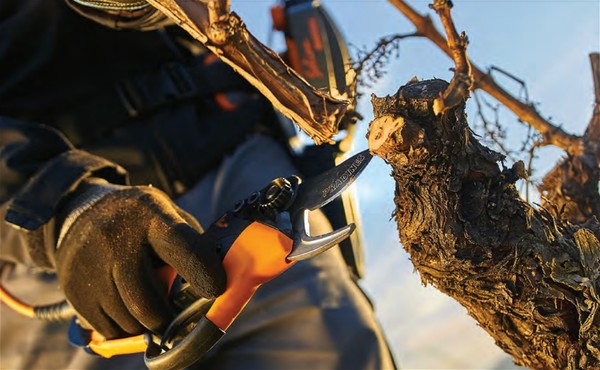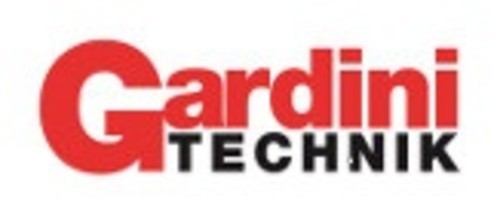
The technical progress of pruning shears
Manual, hydraulic, pneumatic and recently also electronic battery. The professional models of pruning shears used in orchards and vineyards are more and more often equipped with performing lithium-ion batteries. Thanks to dedicated control electronics, they optimize the current consumption to reach the ideal autonomy, of an entire working day
The main objectives of vine pruning concern the maintenance of a specific form of farming, but also to allow appropriate mechanization of the crop, to ensure consistency in time of the production potential and to promote the best quality of the product, both as healthy and as content in sugars, organic acids, mineral salts, tannins, polyphenols, etc. In order to carry out good pruning, the phase of the vital cycle of the plant must be taken into account, along with the interactions between plant-environment and plant-portgraft, vigor and fertility of the buds.
Therefore, dry (or winter) pruning is undoubtedly more important than green (or summer) pruning. The most widely adopted solution to date involves a first coarse operation and a subsequent finishing one. If the former is more and more frequently entirely mechanically performed, the latter is still almost always done manually by specialized operators using specific shears.
In the manual models, the scissors provide three slightly different solutions for the execution of the cut. In fact, while a blade (or the clapper or the striker blade) is solidly attached to the frame of the scissors, the actual edge performs an arching movement to close so as to sever the shoot or branch that has been engaged. The operation control usually involves a trigger activated by the operator, while an accompanying mechanism (spring or similar) provides the opposite movement, opening the blade, for the following cutting routine.
In a more modern way, the movement of the working organ is powered by an external source of energy which drastically reduces both the time required to make each cut and, above all, the physical load on the operator. In this way, it is possible to effortlessly cut branches or shoots with a diameter of up to 40-45 mm. The external energy source that enables the scissors to operate is oil or air, pressurized by a pump or compressor, respectively, or more recently electricity supplied by a battery.
Electronic scissors
The fast improvement of the so-called "energy density" of recent lithium batteries (i.e., the increase of their storage capacity while reducing weight and volume) has led to a significant spread of electronic scissors in which the movement of the blade is carried out by a small electric motor (usually brushless) powered by a battery and controlled electronically.
If compared to manual pruning shears, electronic pruning shears almost exclusively have a through-blade with counter-blade, they weigh more (although the latest models are surprisingly light, even less than 700 g), but on the other hand, they offer a number of significant advantages, both in terms of performance and safety.
First of all, they can quickly cut branches and shoot up to about 40-45 mm in diameter without any effort, thus significantly reducing both the working time and the physical load. Moreover, for maximum efficiency of use, almost all models have four operating modes providing different combinations of speed and amplitude of blade movement.
The progressive cut is beneficial in this sense when the blade moves to close as long as the operator holds the trigger, automatically reversing the direction when it is released. This feature is a significant step forward for the tool's safety, especially for limiting the severity of the injury in case of accidental contact of the blade with the operator's fingers. In fact, if after giving the input for the cut, the edge would make the entire movement, the risk easily imaginable would be that of the complete amputation of the trapped part, while with the so-called "dead man's switch," the feeling of intense pain caused by the start of the cut would instinctively stop the pressure on the trigger, thus allowing the immediate reversal of the movement of the blade. This means that it may be possible to cut tissue, but at least the bone of the affected limb will not be compromised.
Electronic scissors are also usually equipped with a display that can show a number of functions, including the battery charge status and the number of cuts made.
There are models available on the market with different levels of performance (and cost), but they differ substantially in terms of working autonomy and consequently in the size and weight of the battery. Specifically, semi-professional and advanced hobbyist models have the battery integrated (in a removable way, similarly to many tools for manual use) in the body of the scissors. In contrast, professional ones usually have an external battery with a much larger capacity, which simultaneously allows a significant increase in the cutting capacity of the scissors and their operating range. In this latter case, the battery is carried on the shoulder in a backpack expressly provided and obviously connected to the scissors with a power cable.
The professional models
It is precisely for these two features that the pruning shears with backpacks are the most preferred type among professional pruners, mainly because the operational autonomy can last the whole working day. Therefore, it is not surprising that some leading manufacturers of machinery for viticulture have developed models of scissors highly advanced to this purpose.
The French company Pellenc offers the Vinion and Prunion models. The latter stands out for a number of unique features, including the "Pradines" steel cutting blade, coated with xylan (a polymer that improves non-stick and sliding properties when dry), the optical trigger, an ergonomic handle suitable for both right-handed and left-handed users, a blade opening of up to 67 mm for cutting branches up to 45 mm in diameter. Swiss-based manufacturer Felco offers a wide range of pruning shears and scissors, including the 822 model, which features an ergonomic design and a comfortable grip, soft to the touch and non-slip, due to the accurate balancing of the tool. The power pack can be comfortably worn in 5 different positions to suit all body types. Lubrication is carried out with the supplied pump without disassembling the cutting head.
A dedicated app is also available on smartphones or tablets, which displays key tool data, such as the battery charge level and the number and size of cuts made, and also allows customization of settings to optimize work efficiency.
For professional purposes, Zanon of Campodarsego (PD) produces the Tiger SV 38 model, equipped with a blade with titanium nitride coated cutting profile and a counter blade with double sharpening. The scissor is supplied in a carrying case kit, which also includes, of course, a Li-Ion battery pack, model Drive 300.S, which, thanks to its built-in electronics, recognizes the connected tool, thus making it possible to use it for a variety of different devices. The backlit digital display allows easy reading of operating functions, error alarms, and charge levels during use. It is also equipped with a CAN-BUS interface for activating communication and diagnostic procedures. Again at the professional level with backpack batteries, the Brumi of Catania offers the model Pruner-Pro with 1300 W of max power, for cuts with adjustable diameter up to 40 mm. This model has a double display of the conditions of use, both on the scissors and on the battery pack.
The electronic pruner
This is a valuable tool to be used with shears to cut branches (especially fruit trees) over 45-50 mm up to about 250 mm. Several models are available with battery operation, either with direct hand grip or on an extension rod. The working parts are a chain saw or a toothed blade equipped with reciprocating motion. The Zanon of Campodarsego company provides several models. The "Rino due" stands out among those with a chain saw. It is equipped with a 10" bar and ¼" pitch, driven by a powerful 1200 W engine, and provided with an electronic brake and automatic chain tensioner. Chain lubrication is carried out by a mechanical pump that draws oil contained in a tank with a level indicator. As an alternative, the Marlin range of reciprocating saws is equipped with counterbalancing masses, which considerably reduce vibrations during cuts. The pruning body can be oriented in different ways so that it is easy to reach the branch to be cut, even in the case of, particularly dense foliage. Similarly, Campagnola of Zola Predosa (BO) has different models of chainsaw pruners in its catalog, including the agile T-Cat. Ideal for small trimming jobs, in little more than a kilogram (battery included) it uses a 300 W brushless motor, has a trigger dedicated to adjusting the speed of the chain, a safety switch integrated in the non-slip handle and protection of the bar against kickback.
The battery
This is a crucial component of electronic pruning shears. As with all batteries, the main requirements are autonomy and lightness, two characteristics that can be optimized by increasing the so-called "energy density".
Pellenc offers two types of lithium-ion batteries. The 150P, to be hooked to the belt, with a mass of only 850 g, ensures a maximum power of 1730 W for the autonomy of up to 9 hours of operation and 800 recharge cycles. For higher needs, the 250 backpack model is available, which with only 1700 g provides up to 12 hours of autonomy, 1000 recharge cycles, but most importantly, enables the combined use of the pruning shear and the pruner (with a chain saw or reciprocating tooth saw), in this case for up to a 9-hour autonomy.
To recharge the batteries in remote places, Pellenc offers Solerion, a package consisting of a photovoltaic panel of about 2 m² of 280 W peak, which generates a maximum current of 5.2 A at 50.2 V voltage. The module is held by a frame that sets it at the optimal inclination and is integrated with MPPT (Maximum Power Point Tracking) (Maximum Power Point Tracking) control electronics to constantly obtain the maximum power from the photovoltaic panel in order to adjust the battery's charging capacity best.
Maintenance
Since we are dealing with pruning shears, it is obviously essential that the blade constantly maintains the best cutting edge.
For its pruning shears, the Swiss company Felco offers a specific multi-function sharpener for sharpening, rounding, and adjusting the tool, which uses tungsten carbide inserts.
Among the many ranges of tools produced by the Bahco group, there is also a line of pruning tools, which provides, among the accessories, various natural and synthetic stones for sharpening, as well as a sharpener with two tungsten carbide cutting edges, which ensures a high level of safety in its use, because of two lateral loop protections that prevent fingers from slipping on the cutting edge of the blade.
For the cleaning of the pruning shears, particularly the blade, on which there may be residues of resin and other adhesive plant material, specific chemical products are dedicated, often available in spray form.
Felco also offers a biodegradable preparation, without PTFE or silicone, without VOC solvent, with a high foaming power, so as to reduce the amount of detergent required.
Lastly, the parts subject to friction (e.g.the bolt of the shear head) must be conveniently lubricated, typically with synthetic zinc dialkyldithiophosphate grease.








